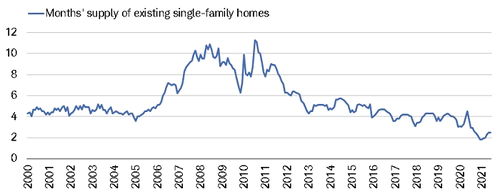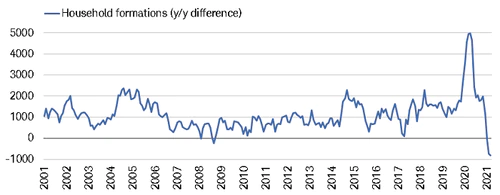Originally published on Schwab.com by Liz Ann Sonders.
In the years leading up to the 2007 real estate bust and subsequent Global Financial Crisis (GFC), housing was a topic I wrote about often. It’s been a while since I dedicated one of these missives to the topic; and given how hot the real estate market has been in the COVID era, it’s time for a detailed look. This report will be chart-heavier, word-lighter; and I’ll continue to keep everyone updated via my Twitter feed.
My husband and I were chatting last weekend about just how surreal the past 18 months have been. If someone came from the future back in February 2020 and landed on our doorstep, laying out what was to come over the subsequent year-and-a-half, I daresay we would have checked to see if we were being punk’d. Not only did the bear market in stocks last a mere five weeks, the bull market since then has been nothing short of remarkable. The housing market has been an even higher-powered rocket ship; something even the most ardent real estate bulls couldn’t have predicted.
Home sweet home
I won’t rehash the drivers—most readers are likely fully aware of the unique characteristics of the COVID era and its contribution to the real estate boom—in terms of work-from-home mobility, need-for-space, and urban-to-suburban drivers; as well as ample liquidity, low mortgage rates, and record-high household net worth.
As shown in the two charts below, sales of both new and existing homes plunged to an unprecedented degree during the GFC; ultimately bottoming around 2010. The ascent from those lows was impressive; but did not take out the pre-GFC highs. When the pandemic erupted last year, sales went into another tailspin; but it was more-than-matched by the speed and trajectory of the recovery. As you can see though, sales have come well off the boil (more on that later); especially for high-priced (above $1 million) homes.
Home Sales Weakening 
Source: Charles Schwab, Bloomberg, as of 6/30/2021.

Higher-End Sales Weakening 
Source: Charles Schwab, Bloomberg, as of 6/30/2021.
Cure for high prices …
There is a popular axiom—often applied to commodity prices—that the cure for high prices is high prices. A twist on this certainly applies to what’s been happening in the housing market recently. As shown below, whereas home sales’ volumes never took out their pre-GFC highs, the same cannot be said about home prices. The median prices of both new and existing homes have gone parabolic over the past year. The pre-GFC price peak for new homes was about $260k, while it recently hit an all-time high of about $370k. The pre-GFC price peak for existing homes was about $230k, while it now sits at an all-time high of more than $360k.
Home Prices in Stratosphere 
Source: Charles Schwab, Bloomberg, as of 6/30/2021.

One of the culprits of the parabolic ascent in home prices has been the deficit of inventory additions. Building permits obviously lead housing starts; but are closely correlated as you can see below. Additions to inventory have been below demand levels, and as such, prices have surged.
Building Permits Have Rolled Over 
Source: Charles Schwab, Bloomberg, as of 6/30/2021.
Inventories are shown directly below; with the monthly supply (based on sales activity) of both new and existing home sales having plunged to record-low territory … until recently, that is. The surge in prices has lit a fire under homeowners to hit the bid; while at the same time, demand has been dented.
Low (But Rising) Inventories


What goes up …
The Chief Economist of the National Association of Realtors (NAR), Lawrence Yun—frequently quoted these days—recently noted that the lack of affordability is “squeezing some of the buyers of the market.” In fact, even if “homebuyers qualify for a mortgage based on their income; with prices rising 20% or higher, it is simply pricing them out.”
More potential home buyers having been priced out of the market is one reason for the retreat in mortgage applications, as shown in the first chart below. That said, given extremely low mortgage rates and generally strong income gains, housing affordability remains fairly high (though off recent peaks).
Mortgage Applications Decelerating

Housing Affordability Deteriorating

Even the most ardent real estate bulls have conceded that some of the spikes in activity/sales/prices would not be sustainable. The pandemic has brought a unique set of ingredients for the recipe of this cycle’s real estate boom. In particular, household formations spiked last year to an unprecedented degree; but the plunge since then is equally eye-popping, as shown in the first chart below. In turn, the homeownership rate has also reversed from its pandemic-induced surge last year, as shown in the second chart below.
Household Formations’ Wild Ride

Homeownership Rate in Decline 
Source: Charles Schwab, Bloomberg, as of 6/30/2021.
Home builders’ sentiment, as measured by the NAHB/Wells Fargo Housing Market Index (shown below) has begun to shift as well. During the very early days of the pandemic, builders’ optimism, which had been steadily rising in 2019, plunged well into negative territory (although not to the depths of the GFC era in 2009). The speed with which builders’ sentiment rebounded was remarkable; ultimately hitting an all-time high of 90, before its latest mild retreat.
Waning Builder Confidence

Another impact of the pandemic has been on builders’ raw material costs; with lumber being the poster child during this latest cycle. As shown below, lumber prices hit a low of $260 during the worst of the lock-down period in April 2020; then surged to $1000 before their retreat last fall. But alongside the vaccine news last November, which provided a shot in the arm of the equity and real estate markets, lumber prices went parabolic—ultimately peaking at nearly $1700 in May of this year. The surge had several factors associated with it; including supply and demand dislocations—literally, as there was plenty of supply, it was just located in the wrong places.
Lumber’s Wild Ride

In sum
The pandemic’s impact on the housing market has been significant; but appears to be fading as an influence. What does not appear likely is a housing bust akin to what triggered the GFC—which ushered in a period of builders’ dramatic cutbacks in new home construction. In stark contrast to the housing bubble in the pre-2007 era—which had as its culprit horrifically shoddy lending practices and massive leverage tied to mortgage-related derivatives—this cycle’s surge in home sales/prices has been driven by supply not meeting demand.
We would not be surprised to see sales and/or prices continue to come off the boil; but as shown above, housing affordability remains generally healthy, and mortgage rates remain historically low. Were home prices to resume their ascent higher, or mortgage rates begin to creep higher, housing affordability would likely suffer. What is likely though in the near-to-medium term is for building activity to accelerate in the interest of boosting inventories to meet demand.
One of my economic theses, amplified by the effects of the pandemic, is for the U.S. economy to begin shifting toward being more investment-based, and perhaps less consumption-based. Residential investment is likely to be a key component of the investment story that’s set to be told.
Important Disclosures:
The information provided here is for general informational purposes only and should not be considered an individualized recommendation or personalized investment advice. The investment strategies mentioned here may not be suitable for everyone. Each investor needs to review an investment strategy for his or her own particular situation before making any investment decision.
All expressions of opinion are subject to change without notice in reaction to shifting market conditions. Data contained herein from third-party providers is obtained from what are considered reliable sources. However, its accuracy, completeness or reliability cannot be guaranteed. Supporting documentation for any claims or statistical information is available upon request.
Examples provided are for illustrative purposes only and not intended to be reflective of results you can expect to achieve.
Investing involves risk including loss of principal.
Past performance is no guarantee of future results and the opinions presented cannot be viewed as an indicator of future performance.
Commodity-related products, including futures, carry a high level of risk and are not suitable for all investors. Commodity-related products may be extremely volatile, illiquid and can be significantly affected by underlying commodity prices, world events, import controls, worldwide competition, government regulations, and economic conditions, regardless of the length of time shares are held.
Indexes are unmanaged, do not incur management fees, costs and expenses and cannot be invested in directly. For more information on indexes please see www.schwab.com/indexdefinitions.

